-
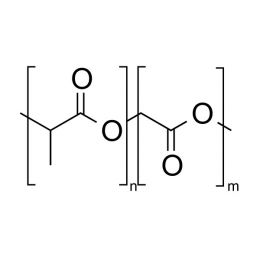 Poly(D,L-lactide-co-glycolide), 90:10, IV 0.2 dl/gCatalog Number 19076
Poly(D,L-lactide-co-glycolide), 90:10, IV 0.2 dl/gCatalog Number 19076Biodegradable polymers. Copolymers are easier to fabricate than homopolymers.
-
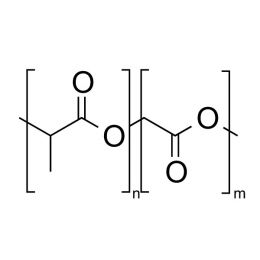 Poly(D,L-lactide-co-glycolide), 85:15, IV 0.85 dL/gCatalog Number 23989
Poly(D,L-lactide-co-glycolide), 85:15, IV 0.85 dL/gCatalog Number 23989Biodegradable polymers. Copolymers are easier to fabricate than homopolymers.
Soluble in: MDC, THF, ethyl acetate, acetone
85/15 i.v. 0.55-0.75
-
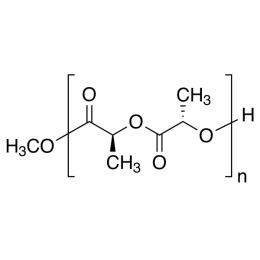 Poly(L-lactic acid), IV 1.8 dl/gCatalog Number 18402
Poly(L-lactic acid), IV 1.8 dl/gCatalog Number 18402Biodegradable polymer. Degradation rate is inversely related to polymer molecular weight.
Crystalline polymer with higher molecular weight polymers having a crystallinity of about 70%.
i.v. 1.30-1.60 Polydispersity ~1.8
-
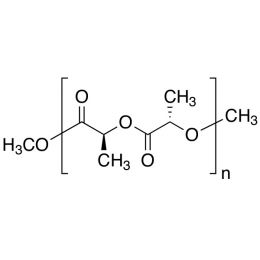 Poly(L-lactic acid) Molecular Weight KitCatalog Number 18599
Poly(L-lactic acid) Molecular Weight KitCatalog Number 18599Biodegradable polymer. Degradation rate is inversely related to polymer molecular weight.
Kit contains:
5g each of polymers with i.v. values of:
- 0.10 - 0.20
- 0.80 - 1.20
- 1.30 - 1.60
- 4.00 - 5.20
-
 Poly(trimethylene carbonate), 1.8 dL/gCatalog Number 26404
Poly(trimethylene carbonate), 1.8 dL/gCatalog Number 26404 -
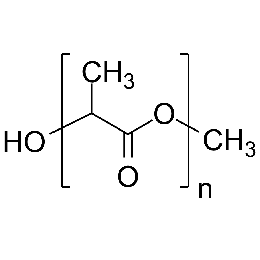 Poly(D,L-lactic acid), IV 0.4 dl/gCatalog Number 16585
Poly(D,L-lactic acid), IV 0.4 dl/gCatalog Number 16585Amorphous, biodegradable polymer. Soluble in: MDC, THF, ethyl acetate, acetone
i.v. 0.35-0.45 Polydispersity 1.8
-
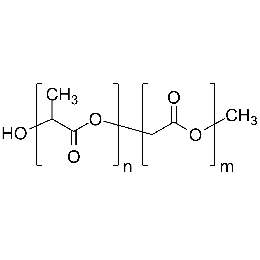 Poly(L-lactide-co-glycolide), 70:30, IV 0.2 dl/gCatalog Number 16587
Poly(L-lactide-co-glycolide), 70:30, IV 0.2 dl/gCatalog Number 16587Biodegradable polymers
70:30 i.v. 0.15-0.30 Polydispersity 1.8
-
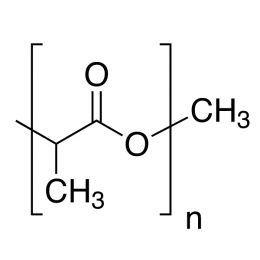 Poly(D,L-lactic acid), IV 2.0 dl/gCatalog Number 23976
Poly(D,L-lactic acid), IV 2.0 dl/gCatalog Number 23976Poly(DL-lactide) (PDLLA) is an ubiquitous biodegradable polymer. It is typically used to fabricate medical devices that predictably degrade over months in physiological conditions. The well-researched release profile also allows for drug-release functionalization with calculable results.1 Owing to its extensive history, PDLLA is one of the most understood and affordable biodegradable polymers for medical devices today.
Synonyms: PDLLA, DL-PLA, PDLA
Specifications
Inherent Viscosity (ηinh): 1.6 - 2.4 dL/g (25°C; CH3Cl, 1.0 g/dL)
Properties
Soluble in: dichloromethane (DCM), tetrahydrofuran (THF), ethyl acetate, acetone
-
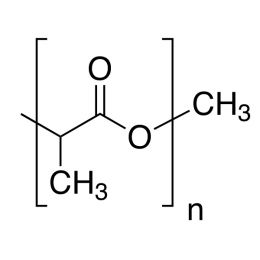 Poly(D,L-lactic acid), IV 0.2 dl/gCatalog Number 22505Inherent Viscosity (ηinh): 0.10 - 0.3 dL/g (25°C; CH3Cl, 1.8 g/dL)
Poly(D,L-lactic acid), IV 0.2 dl/gCatalog Number 22505Inherent Viscosity (ηinh): 0.10 - 0.3 dL/g (25°C; CH3Cl, 1.8 g/dL) -
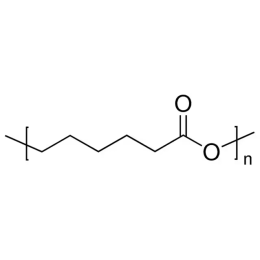 Polycaprolactone, IV 0.2 dL/gCatalog Number 50001Polycaprolactone (PCL) is a biodegradable polymer that is suitable for applications requiring years of stability. In recent years it is becoming of increased interest to manufacturers of medical devices and drug delivery particles.
Polycaprolactone, IV 0.2 dL/gCatalog Number 50001Polycaprolactone (PCL) is a biodegradable polymer that is suitable for applications requiring years of stability. In recent years it is becoming of increased interest to manufacturers of medical devices and drug delivery particles. -
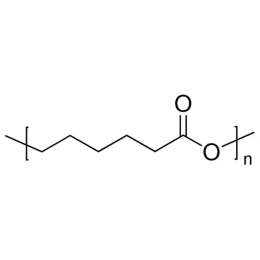 Polycaprolactone, IV 0.4 dL/gCatalog Number 50002Polycaprolactone (PCL) is a biodegradable polymer that is suitable for applications requiring years of stability. In recent years it is becoming of increased interest to manufacturers of medical devices and drug delivery particles.
Polycaprolactone, IV 0.4 dL/gCatalog Number 50002Polycaprolactone (PCL) is a biodegradable polymer that is suitable for applications requiring years of stability. In recent years it is becoming of increased interest to manufacturers of medical devices and drug delivery particles. -
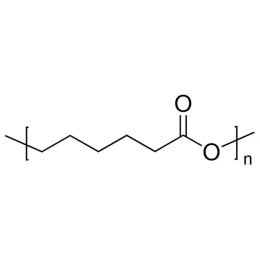 Polycaprolactone, IV 0.8 dL/gCatalog Number 50003Polycaprolactone (PCL) is a biodegradable polymer that is suitable for applications requiring years of stability. In recent years it is becoming of increased interest to manufacturers of medical devices and drug delivery particles.
Polycaprolactone, IV 0.8 dL/gCatalog Number 50003Polycaprolactone (PCL) is a biodegradable polymer that is suitable for applications requiring years of stability. In recent years it is becoming of increased interest to manufacturers of medical devices and drug delivery particles. -
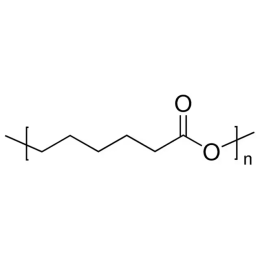 Polycaprolactone, IV 1.2 dL/gCatalog Number 50004Polycaprolactone (PCL) is a biodegradable polymer that is suitable for applications requiring years of stability. In recent years it is becoming of increased interest to manufacturers of medical devices and drug delivery particles.
Polycaprolactone, IV 1.2 dL/gCatalog Number 50004Polycaprolactone (PCL) is a biodegradable polymer that is suitable for applications requiring years of stability. In recent years it is becoming of increased interest to manufacturers of medical devices and drug delivery particles. -
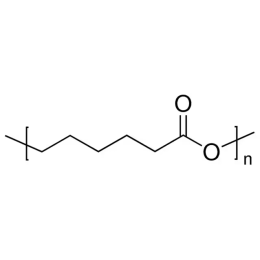 Polycaprolactone, IV 1.7 dL/gCatalog Number 50005Polycaprolactone (PCL) is a biodegradable polymer that is suitable for applications requiring years of stability. In recent years it is becoming of increased interest to manufacturers of medical devices and drug delivery particles.
Polycaprolactone, IV 1.7 dL/gCatalog Number 50005Polycaprolactone (PCL) is a biodegradable polymer that is suitable for applications requiring years of stability. In recent years it is becoming of increased interest to manufacturers of medical devices and drug delivery particles. -
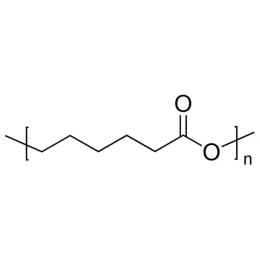 Polycaprolactone, IV 2.0 dL/gCatalog Number 50006Polycaprolactone (PCL) is a biodegradable polymer that is suitable for applications requiring years of stability. In recent years it is becoming of increased interest to manufacturers of medical devices and drug delivery particles.
Polycaprolactone, IV 2.0 dL/gCatalog Number 50006Polycaprolactone (PCL) is a biodegradable polymer that is suitable for applications requiring years of stability. In recent years it is becoming of increased interest to manufacturers of medical devices and drug delivery particles. -
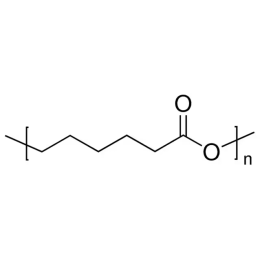 Polycaprolactone, IV 2.2 dL/gCatalog Number 50007Polycaprolactone (PCL) is a biodegradable polymer that is suitable for applications requiring years of stability. In recent years it is becoming of increased interest to manufacturers of medical devices and drug delivery particles.
Polycaprolactone, IV 2.2 dL/gCatalog Number 50007Polycaprolactone (PCL) is a biodegradable polymer that is suitable for applications requiring years of stability. In recent years it is becoming of increased interest to manufacturers of medical devices and drug delivery particles. -
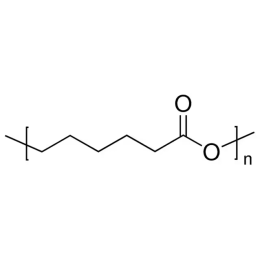 Polycaprolactone, IV 2.6 dL/gCatalog Number 50008Polycaprolactone (PCL) is a biodegradable polymer that is suitable for applications requiring years of stability. In recent years it is becoming of increased interest to manufacturers of medical devices and drug delivery particles.
Polycaprolactone, IV 2.6 dL/gCatalog Number 50008Polycaprolactone (PCL) is a biodegradable polymer that is suitable for applications requiring years of stability. In recent years it is becoming of increased interest to manufacturers of medical devices and drug delivery particles. -
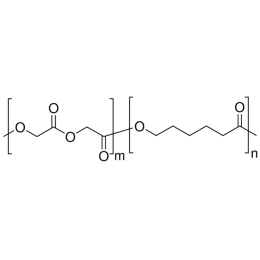 Poly(Caprolactone-co-glycolide), 95:5, IV 1.4 dL/gCatalog Number 50009Poly(Caprolactone-co-glycolide) (PCLGA) is a biodegradable and biocompatible copolymer with a range of potential applications in the biomedical and pharmaceutical industries.
Poly(Caprolactone-co-glycolide), 95:5, IV 1.4 dL/gCatalog Number 50009Poly(Caprolactone-co-glycolide) (PCLGA) is a biodegradable and biocompatible copolymer with a range of potential applications in the biomedical and pharmaceutical industries. -
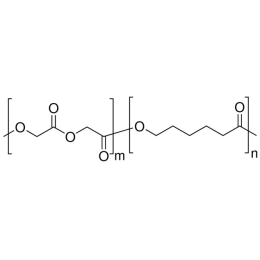 Poly(Caprolactone-co-glycolide), 90:10, IV 0.8 dL/gCatalog Number 50010Poly(Caprolactone-co-glycolide) (PCLGA) is a biodegradable and biocompatible copolymer with a range of potential applications in the biomedical and pharmaceutical industries.
Poly(Caprolactone-co-glycolide), 90:10, IV 0.8 dL/gCatalog Number 50010Poly(Caprolactone-co-glycolide) (PCLGA) is a biodegradable and biocompatible copolymer with a range of potential applications in the biomedical and pharmaceutical industries. -
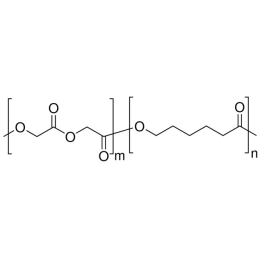 Poly(Caprolactone-co-glycolide), 90:10, IV 1.6 dL/gCatalog Number 50011Poly(Caprolactone-co-glycolide) (PCLGA) is a biodegradable and biocompatible copolymer with a range of potential applications in the biomedical and pharmaceutical industries.
Poly(Caprolactone-co-glycolide), 90:10, IV 1.6 dL/gCatalog Number 50011Poly(Caprolactone-co-glycolide) (PCLGA) is a biodegradable and biocompatible copolymer with a range of potential applications in the biomedical and pharmaceutical industries. -
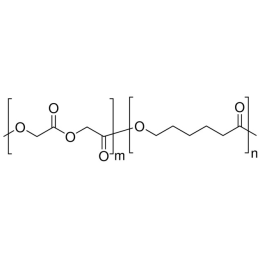 Poly(Caprolactone-co-glycolide), 85:15, IV 1.3 dL/gCatalog Number 50012Poly(Caprolactone-co-glycolide) (PCLGA) is a biodegradable and biocompatible copolymer with a range of potential applications in the biomedical and pharmaceutical industries.
Poly(Caprolactone-co-glycolide), 85:15, IV 1.3 dL/gCatalog Number 50012Poly(Caprolactone-co-glycolide) (PCLGA) is a biodegradable and biocompatible copolymer with a range of potential applications in the biomedical and pharmaceutical industries. -
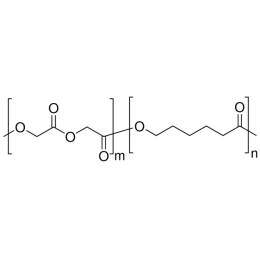 Poly(Caprolactone-co-glycolide), 85:15, IV 1.8 dL/gCatalog Number 50013Poly(Caprolactone-co-glycolide) (PCLGA) is a biodegradable and biocompatible copolymer with a range of potential applications in the biomedical and pharmaceutical industries.
Poly(Caprolactone-co-glycolide), 85:15, IV 1.8 dL/gCatalog Number 50013Poly(Caprolactone-co-glycolide) (PCLGA) is a biodegradable and biocompatible copolymer with a range of potential applications in the biomedical and pharmaceutical industries. -
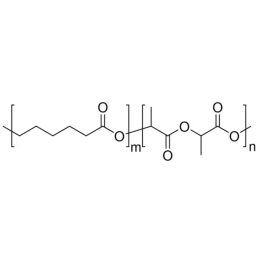 Poly(Caprolactone-co-L-lactide), 95:5, IV 2.1 dL/gCatalog Number 50014Poly(Caprolactone-co-L-lactide) or (PCLLA) is a biodegradable and biocompatible copolymer that has a range of potential applications in the biomedical and pharmaceutical industries.
Poly(Caprolactone-co-L-lactide), 95:5, IV 2.1 dL/gCatalog Number 50014Poly(Caprolactone-co-L-lactide) or (PCLLA) is a biodegradable and biocompatible copolymer that has a range of potential applications in the biomedical and pharmaceutical industries. -
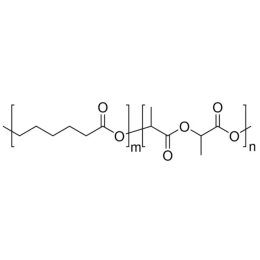 Poly(Caprolactone-co-L-lactide), 90:10, IV 2.0 dL/gCatalog Number 50015Poly(Caprolactone-co-L-lactide) or (PCLLA) is a biodegradable and biocompatible copolymer that has a range of potential applications in the biomedical and pharmaceutical industries.
Poly(Caprolactone-co-L-lactide), 90:10, IV 2.0 dL/gCatalog Number 50015Poly(Caprolactone-co-L-lactide) or (PCLLA) is a biodegradable and biocompatible copolymer that has a range of potential applications in the biomedical and pharmaceutical industries. -
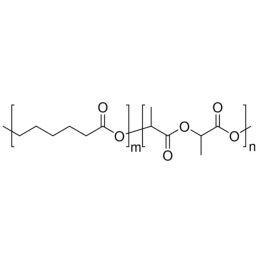 Poly(Caprolactone-co-L-lactide), 85:15, IV 1.8 dL/gCatalog Number 50016Poly(Caprolactone-co-L-lactide) or (PCLLA) is a biodegradable and biocompatible copolymer that has a range of potential applications in the biomedical and pharmaceutical industries.
Poly(Caprolactone-co-L-lactide), 85:15, IV 1.8 dL/gCatalog Number 50016Poly(Caprolactone-co-L-lactide) or (PCLLA) is a biodegradable and biocompatible copolymer that has a range of potential applications in the biomedical and pharmaceutical industries. -
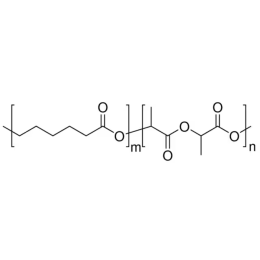 Poly(Caprolactone-co-L-lactide), 85:15, IV 1.3 dL/gCatalog Number 50017Poly(Caprolactone-co-L-lactide) or (PCLLA) is a biodegradable and biocompatible copolymer that has a range of potential applications in the biomedical and pharmaceutical industries.
Poly(Caprolactone-co-L-lactide), 85:15, IV 1.3 dL/gCatalog Number 50017Poly(Caprolactone-co-L-lactide) or (PCLLA) is a biodegradable and biocompatible copolymer that has a range of potential applications in the biomedical and pharmaceutical industries. -
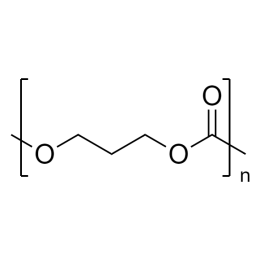 Poly(trimethylene carbonate), IV 0.5 dL/gCatalog Number 50018Poly(trimethylene carbonate) (PTMC) is a highly amorphous, aliphatic polycarbonate known for its flexibility which yields unique functionality in biomedical applications.
Poly(trimethylene carbonate), IV 0.5 dL/gCatalog Number 50018Poly(trimethylene carbonate) (PTMC) is a highly amorphous, aliphatic polycarbonate known for its flexibility which yields unique functionality in biomedical applications. -
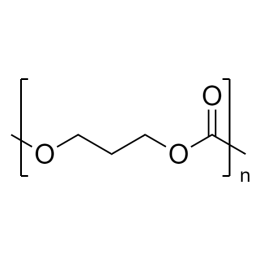 Poly(trimethylene carbonate), IV 1.0 dL/gCatalog Number 50019Poly(trimethylene carbonate) (PTMC) is a highly amorphous, aliphatic polycarbonate known for its flexibility which yields unique functionality in biomedical applications.
Poly(trimethylene carbonate), IV 1.0 dL/gCatalog Number 50019Poly(trimethylene carbonate) (PTMC) is a highly amorphous, aliphatic polycarbonate known for its flexibility which yields unique functionality in biomedical applications. -
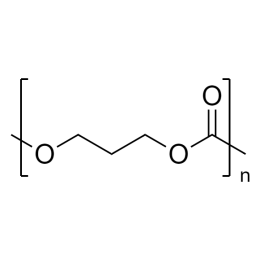 Poly(trimethylene carbonate), IV 1.3 dL/gCatalog Number 50020Poly(trimethylene carbonate) (PTMC) is a highly amorphous, aliphatic polycarbonate known for its flexibility which yields unique functionality in biomedical applications.
Poly(trimethylene carbonate), IV 1.3 dL/gCatalog Number 50020Poly(trimethylene carbonate) (PTMC) is a highly amorphous, aliphatic polycarbonate known for its flexibility which yields unique functionality in biomedical applications. -
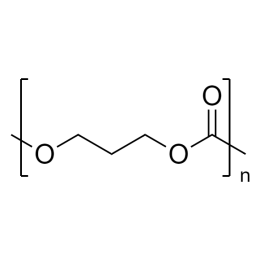 Poly(trimethylene carbonate), IV 1.7 dL/gCatalog Number 50021Poly(trimethylene carbonate) (PTMC) is a highly amorphous, aliphatic polycarbonate known for its flexibility which yields unique functionality in biomedical applications.
Poly(trimethylene carbonate), IV 1.7 dL/gCatalog Number 50021Poly(trimethylene carbonate) (PTMC) is a highly amorphous, aliphatic polycarbonate known for its flexibility which yields unique functionality in biomedical applications. -
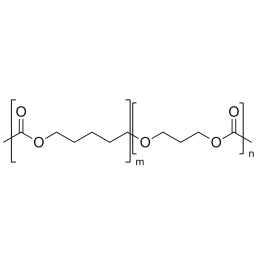 Poly(trimethylene carbonate-co-caprolactone), 90:10, IV 1.1 dL/gCatalog Number 50022Poly(trimethylene carbonate-co-caprolactone) (PTMC-co-PCL) is a biodegradable and biocompatible polymer that has a range of potential applications in the biomedical and pharmaceutical industries and is commonly used as a material for medical devices, 3D printing, tissue engineering scaffolds, and drug delivery.
Poly(trimethylene carbonate-co-caprolactone), 90:10, IV 1.1 dL/gCatalog Number 50022Poly(trimethylene carbonate-co-caprolactone) (PTMC-co-PCL) is a biodegradable and biocompatible polymer that has a range of potential applications in the biomedical and pharmaceutical industries and is commonly used as a material for medical devices, 3D printing, tissue engineering scaffolds, and drug delivery. -
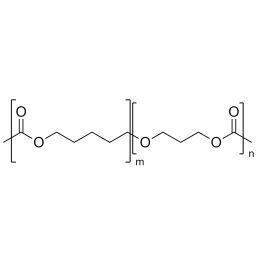 Poly(trimethylene carbonate-co-caprolactone), 80:20, IV 1.5 dL/gCatalog Number 50023Poly(trimethylene carbonate-co-caprolactone) (PTMC-co-PCL) is a biodegradable and biocompatible polymer that has a range of potential applications in the biomedical and pharmaceutical industries and is commonly used as a material for medical devices, 3D printing, tissue engineering scaffolds, and drug delivery.
Poly(trimethylene carbonate-co-caprolactone), 80:20, IV 1.5 dL/gCatalog Number 50023Poly(trimethylene carbonate-co-caprolactone) (PTMC-co-PCL) is a biodegradable and biocompatible polymer that has a range of potential applications in the biomedical and pharmaceutical industries and is commonly used as a material for medical devices, 3D printing, tissue engineering scaffolds, and drug delivery. -
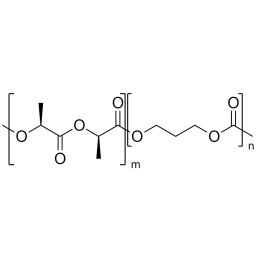 Poly(trimethylene carbonate-co-L-lactide), 90:10, IV 0.7 dL/gCatalog Number 50024Poly(trimethylene carbonate-co-L-lactide) (PTMCLLA) is a biodegradable copolymer that has gained popularity in various biomedical applications, including drug delivery, tissue engineering, and wound healing.
Poly(trimethylene carbonate-co-L-lactide), 90:10, IV 0.7 dL/gCatalog Number 50024Poly(trimethylene carbonate-co-L-lactide) (PTMCLLA) is a biodegradable copolymer that has gained popularity in various biomedical applications, including drug delivery, tissue engineering, and wound healing. -
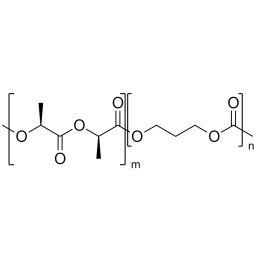 Poly(trimethylene carbonate-co-L-lactide), 80:20, IV 0.9 dL/gCatalog Number 50025Poly(trimethylene carbonate-co-L-lactide) (PTMCLLA) is a biodegradable copolymer that has gained popularity in various biomedical applications, including drug delivery, tissue engineering, and wound healing.
Poly(trimethylene carbonate-co-L-lactide), 80:20, IV 0.9 dL/gCatalog Number 50025Poly(trimethylene carbonate-co-L-lactide) (PTMCLLA) is a biodegradable copolymer that has gained popularity in various biomedical applications, including drug delivery, tissue engineering, and wound healing. -
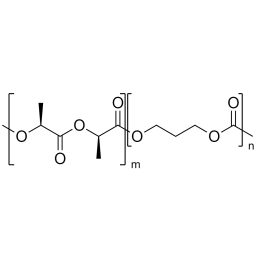 Poly(trimethylene carbonate-co-L-lactide), 80:20, IV 1.1 dL/gCatalog Number 50026Poly(trimethylene carbonate-co-L-lactide) (PTMCLLA) is a biodegradable copolymer that has gained popularity in various biomedical applications, including drug delivery, tissue engineering, and wound healing.
Poly(trimethylene carbonate-co-L-lactide), 80:20, IV 1.1 dL/gCatalog Number 50026Poly(trimethylene carbonate-co-L-lactide) (PTMCLLA) is a biodegradable copolymer that has gained popularity in various biomedical applications, including drug delivery, tissue engineering, and wound healing. -
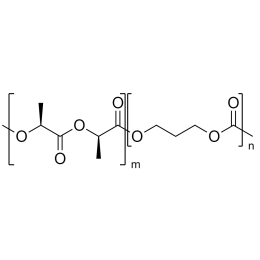 Poly(trimethylene carbonate-co-L-lactide), 60:40, IV 1.0 dL/gCatalog Number 50027Poly(trimethylene carbonate-co-L-lactide) (PTMCLLA) is a biodegradable copolymer that has gained popularity in various biomedical applications, including drug delivery, tissue engineering, and wound healing.
Poly(trimethylene carbonate-co-L-lactide), 60:40, IV 1.0 dL/gCatalog Number 50027Poly(trimethylene carbonate-co-L-lactide) (PTMCLLA) is a biodegradable copolymer that has gained popularity in various biomedical applications, including drug delivery, tissue engineering, and wound healing. -
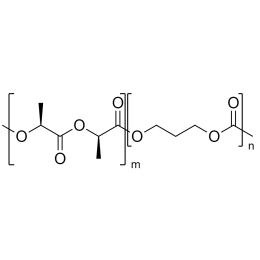 Poly(trimethylene carbonate-co-L-lactide), 60:40, IV 1.2 dL/gCatalog Number 50028Poly(trimethylene carbonate-co-L-lactide) (PTMCLLA) is a biodegradable copolymer that has gained popularity in various biomedical applications, including drug delivery, tissue engineering, and wound healing.
Poly(trimethylene carbonate-co-L-lactide), 60:40, IV 1.2 dL/gCatalog Number 50028Poly(trimethylene carbonate-co-L-lactide) (PTMCLLA) is a biodegradable copolymer that has gained popularity in various biomedical applications, including drug delivery, tissue engineering, and wound healing. -
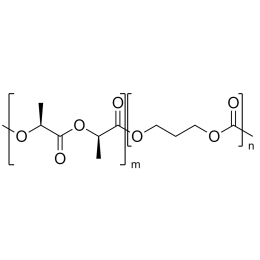 Poly(trimethylene carbonate-co-L-lactide), 50:50, IV 0.9 dL/gCatalog Number 50029Poly(trimethylene carbonate-co-L-lactide) (PTMCLLA) is a biodegradable copolymer that has gained popularity in various biomedical applications, including drug delivery, tissue engineering, and wound healing.
Poly(trimethylene carbonate-co-L-lactide), 50:50, IV 0.9 dL/gCatalog Number 50029Poly(trimethylene carbonate-co-L-lactide) (PTMCLLA) is a biodegradable copolymer that has gained popularity in various biomedical applications, including drug delivery, tissue engineering, and wound healing. -
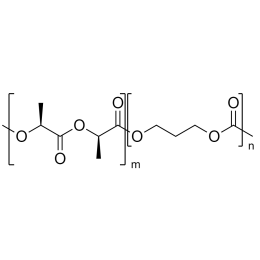 Poly(trimethylene carbonate-co-L-lactide), 50:50, IV 1.1 dL/gCatalog Number 50030Poly(trimethylene carbonate-co-L-lactide) (PTMCLLA) is a biodegradable copolymer that has gained popularity in various biomedical applications, including drug delivery, tissue engineering, and wound healing.
Poly(trimethylene carbonate-co-L-lactide), 50:50, IV 1.1 dL/gCatalog Number 50030Poly(trimethylene carbonate-co-L-lactide) (PTMCLLA) is a biodegradable copolymer that has gained popularity in various biomedical applications, including drug delivery, tissue engineering, and wound healing. -
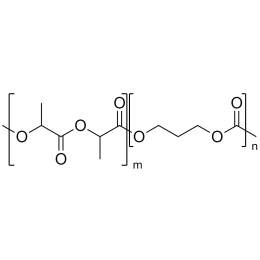 Poly(trimethylene carbonate-co-D,L-lactide), 50:50, IV 1.1 dL/gCatalog Number 50031Poly(trimethylene carbonate-co-L-lactide) (PTMCLLA) is a biodegradable copolymer that has gained popularity in various biomedical applications, including drug delivery, tissue engineering, and wound healing.
Poly(trimethylene carbonate-co-D,L-lactide), 50:50, IV 1.1 dL/gCatalog Number 50031Poly(trimethylene carbonate-co-L-lactide) (PTMCLLA) is a biodegradable copolymer that has gained popularity in various biomedical applications, including drug delivery, tissue engineering, and wound healing. -
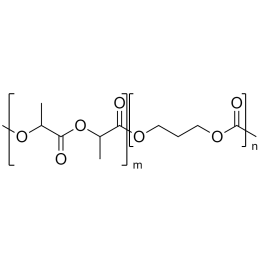 Poly(trimethylene carbonate-co-D,L-lactide), 50:50, IV 0.9 dL/gCatalog Number 50032Poly(trimethylene carbonate-co-L-lactide) (PTMCLLA) is a biodegradable copolymer that has gained popularity in various biomedical applications, including drug delivery, tissue engineering, and wound healing.
Poly(trimethylene carbonate-co-D,L-lactide), 50:50, IV 0.9 dL/gCatalog Number 50032Poly(trimethylene carbonate-co-L-lactide) (PTMCLLA) is a biodegradable copolymer that has gained popularity in various biomedical applications, including drug delivery, tissue engineering, and wound healing. -
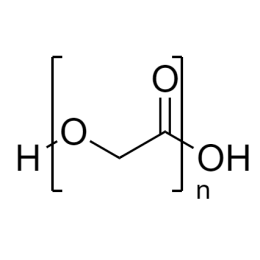 Polyglycolide, IV 0.5 dL/gCatalog Number 50033Polyglycolide (PGA) is an aliphatic polyester with moderate to high crystallinity that is well known for extensive use in biomedical applications which require expedited biodegradation.
Polyglycolide, IV 0.5 dL/gCatalog Number 50033Polyglycolide (PGA) is an aliphatic polyester with moderate to high crystallinity that is well known for extensive use in biomedical applications which require expedited biodegradation. -
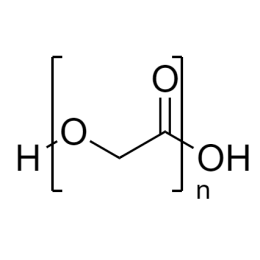 Polyglycolide, IV 1.2 dL/gCatalog Number 50034Polyglycolide (PGA) is an aliphatic polyester with moderate to high crystallinity that is well known for extensive use in biomedical applications which require expedited biodegradation.
Polyglycolide, IV 1.2 dL/gCatalog Number 50034Polyglycolide (PGA) is an aliphatic polyester with moderate to high crystallinity that is well known for extensive use in biomedical applications which require expedited biodegradation. -
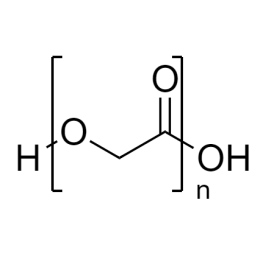 Polyglycolide, IV 1.6 dL/gCatalog Number 50035Polyglycolide (PGA) is an aliphatic polyester with moderate to high crystallinity that is well known for extensive use in biomedical applications which require expedited biodegradation.
Polyglycolide, IV 1.6 dL/gCatalog Number 50035Polyglycolide (PGA) is an aliphatic polyester with moderate to high crystallinity that is well known for extensive use in biomedical applications which require expedited biodegradation. -
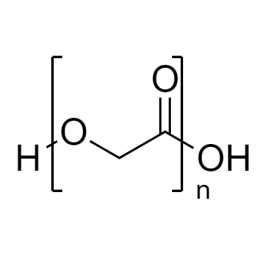 Polyglycolide, IV 2.0 dL/gCatalog Number 50036Polyglycolide (PGA) is an aliphatic polyester with moderate to high crystallinity that is well known for extensive use in biomedical applications which require expedited biodegradation.
Polyglycolide, IV 2.0 dL/gCatalog Number 50036Polyglycolide (PGA) is an aliphatic polyester with moderate to high crystallinity that is well known for extensive use in biomedical applications which require expedited biodegradation. -
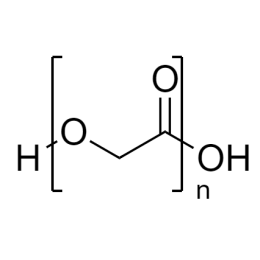 Polyglycolide, IV 2.5 dL/gCatalog Number 50037Polyglycolide (PGA) is an aliphatic polyester with moderate to high crystallinity that is well known for extensive use in biomedical applications which require expedited biodegradation.
Polyglycolide, IV 2.5 dL/gCatalog Number 50037Polyglycolide (PGA) is an aliphatic polyester with moderate to high crystallinity that is well known for extensive use in biomedical applications which require expedited biodegradation. -
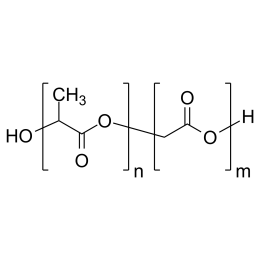 Poly(glycolide-co-lactide), 95:5, IV 1.7 dL/gCatalog Number 50038Poly(glycolide-co-lactide) (PGLA) is a biodegradable copolymer widely used in medical applications, such as sutures, drug delivery systems, 3D printing, and tissue engineering, due to its excellent biocompatibility and controlled biodegradability.
Poly(glycolide-co-lactide), 95:5, IV 1.7 dL/gCatalog Number 50038Poly(glycolide-co-lactide) (PGLA) is a biodegradable copolymer widely used in medical applications, such as sutures, drug delivery systems, 3D printing, and tissue engineering, due to its excellent biocompatibility and controlled biodegradability. -
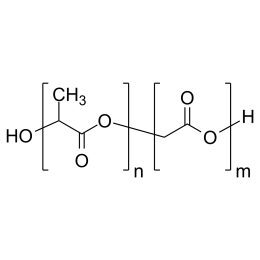 Poly(glycolide-co-lactide), 90:10, IV 1.7 dL/gCatalog Number 50039Poly(glycolide-co-lactide) (PGLA) is a biodegradable copolymer widely used in medical applications, such as sutures, drug delivery systems, 3D printing, and tissue engineering, due to its excellent biocompatibility and controlled biodegradability.
Poly(glycolide-co-lactide), 90:10, IV 1.7 dL/gCatalog Number 50039Poly(glycolide-co-lactide) (PGLA) is a biodegradable copolymer widely used in medical applications, such as sutures, drug delivery systems, 3D printing, and tissue engineering, due to its excellent biocompatibility and controlled biodegradability. -
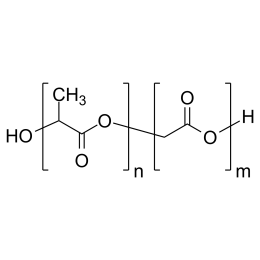 Poly(glycolide-co-lactide), 80:20, IV 1.8 dL/gCatalog Number 50040Poly(glycolide-co-lactide) (PGLA) is a biodegradable copolymer widely used in medical applications, such as sutures, drug delivery systems, 3D printing, and tissue engineering, due to its excellent biocompatibility and controlled biodegradability.
Poly(glycolide-co-lactide), 80:20, IV 1.8 dL/gCatalog Number 50040Poly(glycolide-co-lactide) (PGLA) is a biodegradable copolymer widely used in medical applications, such as sutures, drug delivery systems, 3D printing, and tissue engineering, due to its excellent biocompatibility and controlled biodegradability. -
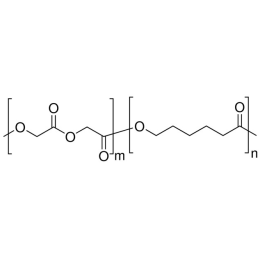 Poly(glycolide-co-caprolactone), 75:25, 1.6 dL/gCatalog Number 50041Poly(glycolide-co-caprolactone) (PGCL) is a biodegradable copolymer suitable for medical and pharmaceutical applications, such as drug delivery systems, 3D printing, tissue engineering, and wound healing.
Poly(glycolide-co-caprolactone), 75:25, 1.6 dL/gCatalog Number 50041Poly(glycolide-co-caprolactone) (PGCL) is a biodegradable copolymer suitable for medical and pharmaceutical applications, such as drug delivery systems, 3D printing, tissue engineering, and wound healing. -
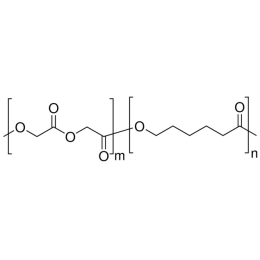 Poly(glycolide-co-caprolactone), 60:40, 1.4 dL/gCatalog Number 50042Poly(glycolide-co-caprolactone) (PGCL) is a biodegradable copolymer suitable for medical and pharmaceutical applications, such as drug delivery systems, 3D printing, tissue engineering, and wound healing.
Poly(glycolide-co-caprolactone), 60:40, 1.4 dL/gCatalog Number 50042Poly(glycolide-co-caprolactone) (PGCL) is a biodegradable copolymer suitable for medical and pharmaceutical applications, such as drug delivery systems, 3D printing, tissue engineering, and wound healing. -
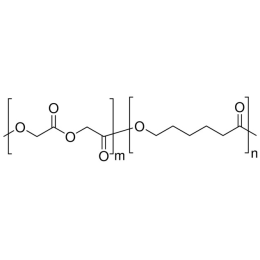 Poly(glycolide-co-caprolactone), 60:40, 1.3 dL/gCatalog Number 50043Poly(glycolide-co-caprolactone) (PGCL) is a biodegradable copolymer suitable for medical and pharmaceutical applications, such as drug delivery systems, 3D printing, tissue engineering, and wound healing.
Poly(glycolide-co-caprolactone), 60:40, 1.3 dL/gCatalog Number 50043Poly(glycolide-co-caprolactone) (PGCL) is a biodegradable copolymer suitable for medical and pharmaceutical applications, such as drug delivery systems, 3D printing, tissue engineering, and wound healing. -
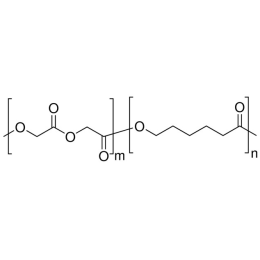 Poly(glycolide-co-caprolactone), 55:45, 1.5 dL/gCatalog Number 50044Poly(glycolide-co-caprolactone) (PGCL) is a biodegradable copolymer suitable for medical and pharmaceutical applications, such as drug delivery systems, 3D printing, tissue engineering, and wound healing.
Poly(glycolide-co-caprolactone), 55:45, 1.5 dL/gCatalog Number 50044Poly(glycolide-co-caprolactone) (PGCL) is a biodegradable copolymer suitable for medical and pharmaceutical applications, such as drug delivery systems, 3D printing, tissue engineering, and wound healing. -
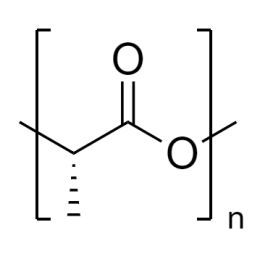 Poly(L-lactide), IV 1.6 dL/gCatalog Number 50045Poly(L-lactide) (PLLA) is a biodegradable polymer typically used to fabricate resorbable medical devices that degrade over months in physiological conditions.
Poly(L-lactide), IV 1.6 dL/gCatalog Number 50045Poly(L-lactide) (PLLA) is a biodegradable polymer typically used to fabricate resorbable medical devices that degrade over months in physiological conditions. -
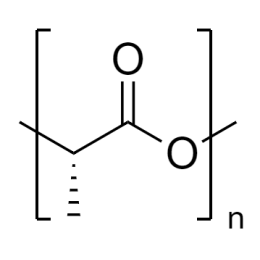 Poly(L-lactide), IV 2.0 dL/gCatalog Number 50046Poly(L-lactide) (PLLA) is a biodegradable polymer typically used to fabricate resorbable medical devices that degrade over months in physiological conditions.
Poly(L-lactide), IV 2.0 dL/gCatalog Number 50046Poly(L-lactide) (PLLA) is a biodegradable polymer typically used to fabricate resorbable medical devices that degrade over months in physiological conditions. -
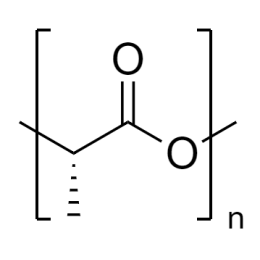 Poly(L-lactide), IV 2.4 dL/gCatalog Number 50047Poly(L-lactide) (PLLA) is a biodegradable polymer typically used to fabricate resorbable medical devices that degrade over months in physiological conditions.
Poly(L-lactide), IV 2.4 dL/gCatalog Number 50047Poly(L-lactide) (PLLA) is a biodegradable polymer typically used to fabricate resorbable medical devices that degrade over months in physiological conditions. -
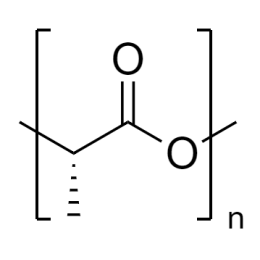 Poly(L-lactide), IV 3.2 dL/gCatalog Number 50048Poly(L-lactide) (PLLA) is a biodegradable polymer typically used to fabricate resorbable medical devices that degrade over months in physiological conditions.
Poly(L-lactide), IV 3.2 dL/gCatalog Number 50048Poly(L-lactide) (PLLA) is a biodegradable polymer typically used to fabricate resorbable medical devices that degrade over months in physiological conditions. -
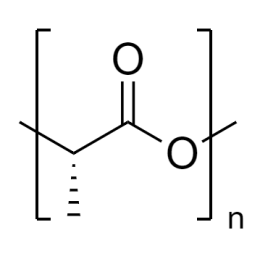 Poly(L-lactide), IV 3.8 dL/gCatalog Number 50049Poly(L-lactide) (PLLA) is a biodegradable polymer typically used to fabricate resorbable medical devices that degrade over months in physiological conditions.
Poly(L-lactide), IV 3.8 dL/gCatalog Number 50049Poly(L-lactide) (PLLA) is a biodegradable polymer typically used to fabricate resorbable medical devices that degrade over months in physiological conditions. -
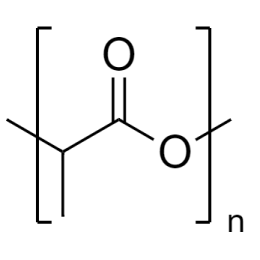 Poly(D,L-lactic acid), IV 0.4 dL/g, acid terminatedCatalog Number 50050Poly(DL-lactide) (PDLLA) is a biodegradable polymer typically used to fabricate medical devices that predictably degrade over months in physiological conditions.
Poly(D,L-lactic acid), IV 0.4 dL/g, acid terminatedCatalog Number 50050Poly(DL-lactide) (PDLLA) is a biodegradable polymer typically used to fabricate medical devices that predictably degrade over months in physiological conditions. -
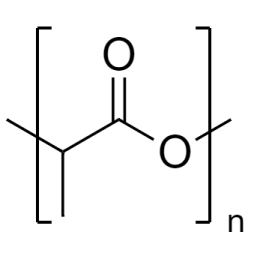 Poly(D,L-lactic acid), IV 0.5 dL/gCatalog Number 50051Poly(DL-lactide) (PDLLA) is a biodegradable polymer typically used to fabricate medical devices that predictably degrade over months in physiological conditions.
Poly(D,L-lactic acid), IV 0.5 dL/gCatalog Number 50051Poly(DL-lactide) (PDLLA) is a biodegradable polymer typically used to fabricate medical devices that predictably degrade over months in physiological conditions. -
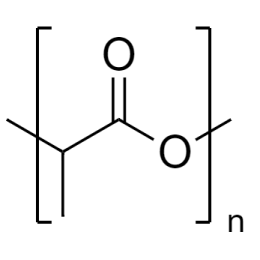 Poly(D,L-lactic acid), IV 0.6 dL/gCatalog Number 50052Poly(DL-lactide) (PDLLA) is a biodegradable polymer typically used to fabricate medical devices that predictably degrade over months in physiological conditions.
Poly(D,L-lactic acid), IV 0.6 dL/gCatalog Number 50052Poly(DL-lactide) (PDLLA) is a biodegradable polymer typically used to fabricate medical devices that predictably degrade over months in physiological conditions. -
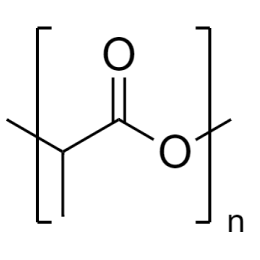 Poly(D,L-lactic acid), IV 0.9 dL/gCatalog Number 50053Poly(DL-lactide) (PDLLA) is a biodegradable polymer typically used to fabricate medical devices that predictably degrade over months in physiological conditions.
Poly(D,L-lactic acid), IV 0.9 dL/gCatalog Number 50053Poly(DL-lactide) (PDLLA) is a biodegradable polymer typically used to fabricate medical devices that predictably degrade over months in physiological conditions. -
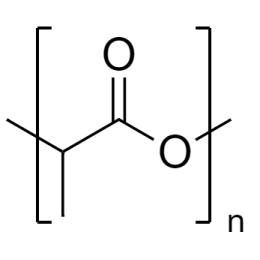 Poly(D,L-lactic acid), IV 1.2 dL/gCatalog Number 50054Poly(DL-lactide) (PDLLA) is a biodegradable polymer typically used to fabricate medical devices that predictably degrade over months in physiological conditions.
Poly(D,L-lactic acid), IV 1.2 dL/gCatalog Number 50054Poly(DL-lactide) (PDLLA) is a biodegradable polymer typically used to fabricate medical devices that predictably degrade over months in physiological conditions. -
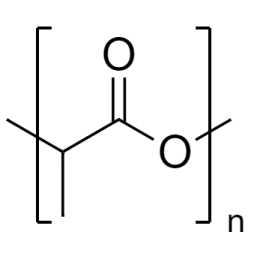 Poly(D,L-lactic acid), IV 1.6 dL/gCatalog Number 50055Poly(DL-lactide) (PDLLA) is a biodegradable polymer typically used to fabricate medical devices that predictably degrade over months in physiological conditions.
Poly(D,L-lactic acid), IV 1.6 dL/gCatalog Number 50055Poly(DL-lactide) (PDLLA) is a biodegradable polymer typically used to fabricate medical devices that predictably degrade over months in physiological conditions. -
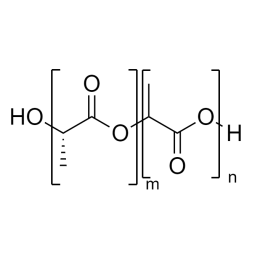 Poly(L-lactide-co-D,L-lactide), 70:30, IV 2.4 dL/gCatalog Number 50056Poly(L-lactide-co-D,L-lactide) (PDLLA) is a biodegradable polymer typically used to fabricate medical devices that predictably degrade over years in physiological conditions.
Poly(L-lactide-co-D,L-lactide), 70:30, IV 2.4 dL/gCatalog Number 50056Poly(L-lactide-co-D,L-lactide) (PDLLA) is a biodegradable polymer typically used to fabricate medical devices that predictably degrade over years in physiological conditions. -
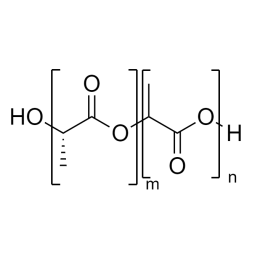 Poly(L-lactide-co-D,L-lactide), 70:30, IV 2.6 dL/gCatalog Number 50057Poly(L-lactide-co-D,L-lactide) (PDLLA) is a biodegradable polymer typically used to fabricate medical devices that predictably degrade over years in physiological conditions.
Poly(L-lactide-co-D,L-lactide), 70:30, IV 2.6 dL/gCatalog Number 50057Poly(L-lactide-co-D,L-lactide) (PDLLA) is a biodegradable polymer typically used to fabricate medical devices that predictably degrade over years in physiological conditions. -
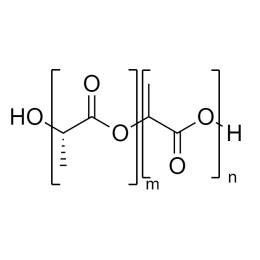 Poly(L-lactide-co-D,L-lactide), 70:30, IV 2.8 dL/gCatalog Number 50058Poly(L-lactide-co-D,L-lactide) (PDLLA) is a biodegradable polymer typically used to fabricate medical devices that predictably degrade over years in physiological conditions.
Poly(L-lactide-co-D,L-lactide), 70:30, IV 2.8 dL/gCatalog Number 50058Poly(L-lactide-co-D,L-lactide) (PDLLA) is a biodegradable polymer typically used to fabricate medical devices that predictably degrade over years in physiological conditions. -
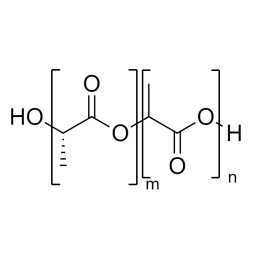 Poly(L-lactide-co-D,L-lactide), 70:30, IV 3.8 dL/gCatalog Number 50059Poly(L-lactide-co-D,L-lactide) (PDLLA) is a biodegradable polymer typically used to fabricate medical devices that predictably degrade over years in physiological conditions.
Poly(L-lactide-co-D,L-lactide), 70:30, IV 3.8 dL/gCatalog Number 50059Poly(L-lactide-co-D,L-lactide) (PDLLA) is a biodegradable polymer typically used to fabricate medical devices that predictably degrade over years in physiological conditions. -
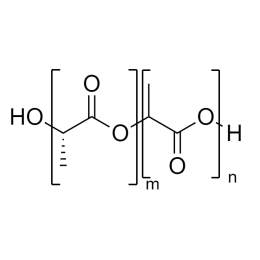 Poly(L-lactide-co-D,L-lactide), 70:30, IV 6.0 dL/gCatalog Number 50060Poly(L-lactide-co-D,L-lactide) (PDLLA) is a biodegradable polymer typically used to fabricate medical devices that predictably degrade over years in physiological conditions.
Poly(L-lactide-co-D,L-lactide), 70:30, IV 6.0 dL/gCatalog Number 50060Poly(L-lactide-co-D,L-lactide) (PDLLA) is a biodegradable polymer typically used to fabricate medical devices that predictably degrade over years in physiological conditions. -
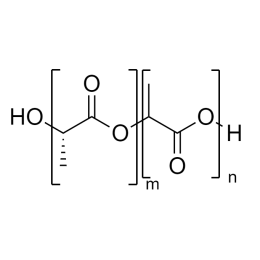 Poly(L-lactide-co-D,L-lactide), 80:20, IV 3.8 dL/gCatalog Number 50061Poly(L-lactide-co-D,L-lactide) (PDLLA) is a biodegradable polymer typically used to fabricate medical devices that predictably degrade over years in physiological conditions.
Poly(L-lactide-co-D,L-lactide), 80:20, IV 3.8 dL/gCatalog Number 50061Poly(L-lactide-co-D,L-lactide) (PDLLA) is a biodegradable polymer typically used to fabricate medical devices that predictably degrade over years in physiological conditions. -
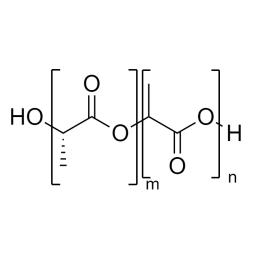 Poly(L-lactide-co-D,L-lactide), 80:20, IV 5.8 dL/gCatalog Number 50062Poly(L-lactide-co-D,L-lactide) (PDLLA) is a biodegradable polymer typically used to fabricate medical devices that predictably degrade over years in physiological conditions.
Poly(L-lactide-co-D,L-lactide), 80:20, IV 5.8 dL/gCatalog Number 50062Poly(L-lactide-co-D,L-lactide) (PDLLA) is a biodegradable polymer typically used to fabricate medical devices that predictably degrade over years in physiological conditions. -
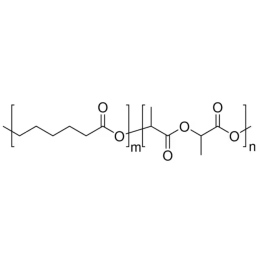 Poly(L-lactide co-Caprolactone), 60:40, IV 1.8 dL/gCatalog Number 50063Poly(L-lactide co-caprolactone) is a biodegradable copolymer with applications in various fields, including tissue engineering, drug delivery systems, and packaging materials due to its longer degradation profile and compatibility with biological systems.
Poly(L-lactide co-Caprolactone), 60:40, IV 1.8 dL/gCatalog Number 50063Poly(L-lactide co-caprolactone) is a biodegradable copolymer with applications in various fields, including tissue engineering, drug delivery systems, and packaging materials due to its longer degradation profile and compatibility with biological systems. -
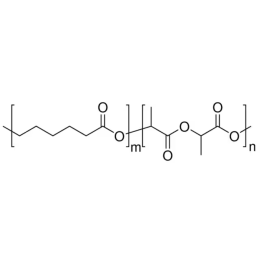 Poly(L-lactide co-Caprolactone), 70:30, IV 1.5 dL/gCatalog Number 50064Poly(L-lactide co-caprolactone) is a biodegradable copolymer with applications in various fields, including tissue engineering, drug delivery systems, and packaging materials due to its longer degradation profile and compatibility with biological systems.
Poly(L-lactide co-Caprolactone), 70:30, IV 1.5 dL/gCatalog Number 50064Poly(L-lactide co-caprolactone) is a biodegradable copolymer with applications in various fields, including tissue engineering, drug delivery systems, and packaging materials due to its longer degradation profile and compatibility with biological systems. -
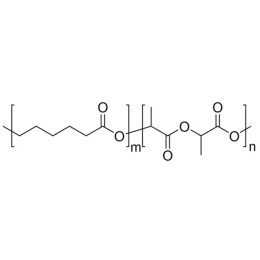 Poly(DL-lactide co-Caprolactone), 80:20, IV 2.0 dL/gCatalog Number 50065Poly(DL-lactide co-caprolactone) is a biodegradable copolymer with applications in various fields, including tissue engineering, drug delivery systems, and packaging materials due to its longer degradation profile and compatibility with biological systems.
Poly(DL-lactide co-Caprolactone), 80:20, IV 2.0 dL/gCatalog Number 50065Poly(DL-lactide co-caprolactone) is a biodegradable copolymer with applications in various fields, including tissue engineering, drug delivery systems, and packaging materials due to its longer degradation profile and compatibility with biological systems. -
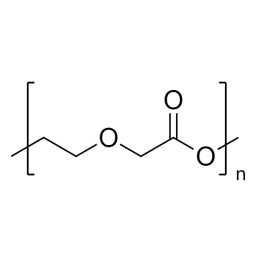 Polydioxanone, IV 1.7 dL/gCatalog Number 50066Polydioxanone (PDO) is a polylactone ester with high degrees of crystallinity and is known for its use in filament sutures, meshes, clips, and other flexible absorbable devices.
Polydioxanone, IV 1.7 dL/gCatalog Number 50066Polydioxanone (PDO) is a polylactone ester with high degrees of crystallinity and is known for its use in filament sutures, meshes, clips, and other flexible absorbable devices. -
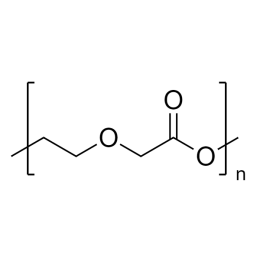 Polydioxanone, IV 1.9 dL/gCatalog Number 50067Polydioxanone (PDO) is a polylactone ester with high degrees of crystallinity and is known for its use in filament sutures, meshes, clips, and other flexible absorbable devices.
Polydioxanone, IV 1.9 dL/gCatalog Number 50067Polydioxanone (PDO) is a polylactone ester with high degrees of crystallinity and is known for its use in filament sutures, meshes, clips, and other flexible absorbable devices. -
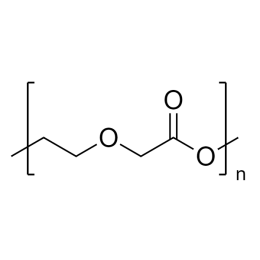 Polydioxanone, IV 2.5 dL/gCatalog Number 50068Polydioxanone (PDO) is a polylactone ester with high degrees of crystallinity and is known for its use in filament sutures, meshes, clips, and other flexible absorbable devices.
Polydioxanone, IV 2.5 dL/gCatalog Number 50068Polydioxanone (PDO) is a polylactone ester with high degrees of crystallinity and is known for its use in filament sutures, meshes, clips, and other flexible absorbable devices. -
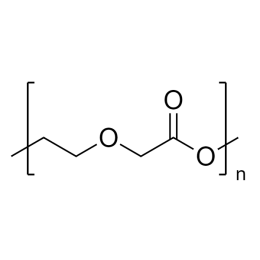 Polydioxanone, dyed, IV 1.6 dL/gCatalog Number 50069Inquire for availability.Phone: +(49) 6201-845200Email: [email protected]Polydioxanone (PDO) is a polylactone ester with high degrees of crystallinity and is known for its use in filament sutures, meshes, clips, and other flexible absorbable devices.
Polydioxanone, dyed, IV 1.6 dL/gCatalog Number 50069Inquire for availability.Phone: +(49) 6201-845200Email: [email protected]Polydioxanone (PDO) is a polylactone ester with high degrees of crystallinity and is known for its use in filament sutures, meshes, clips, and other flexible absorbable devices. -
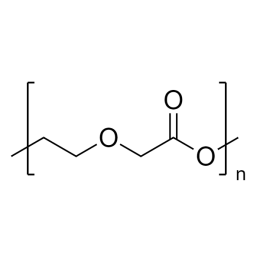 Polydioxanone, dyed, IV 2.0 dL/gCatalog Number 50070Inquire for availability.Phone: +(49) 6201-845200Email: [email protected]Polydioxanone (PDO) is a polylactone ester with high degrees of crystallinity and is known for its use in filament sutures, meshes, clips, and other flexible absorbable devices.
Polydioxanone, dyed, IV 2.0 dL/gCatalog Number 50070Inquire for availability.Phone: +(49) 6201-845200Email: [email protected]Polydioxanone (PDO) is a polylactone ester with high degrees of crystallinity and is known for its use in filament sutures, meshes, clips, and other flexible absorbable devices. -
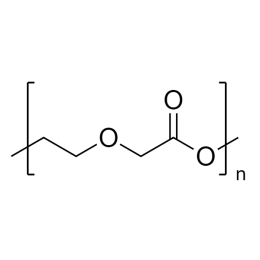 Polydioxanone, dyed, IV 2.2 dL/gCatalog Number 50071Inquire for availability.Phone: +(49) 6201-845200Email: [email protected]Polydioxanone (PDO) is a polylactone ester with high degrees of crystallinity and is known for its use in filament sutures, meshes, clips, and other flexible absorbable devices.
Polydioxanone, dyed, IV 2.2 dL/gCatalog Number 50071Inquire for availability.Phone: +(49) 6201-845200Email: [email protected]Polydioxanone (PDO) is a polylactone ester with high degrees of crystallinity and is known for its use in filament sutures, meshes, clips, and other flexible absorbable devices. -
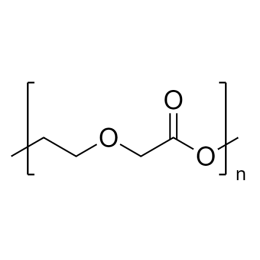 Polydioxanone, dyed, IV 3.1 dL/gCatalog Number 50072Inquire for availability.Phone: +(49) 6201-845200Email: [email protected]Polydioxanone (PDO) is a polylactone ester with high degrees of crystallinity and is known for its use in filament sutures, meshes, clips, and other flexible absorbable devices.
Polydioxanone, dyed, IV 3.1 dL/gCatalog Number 50072Inquire for availability.Phone: +(49) 6201-845200Email: [email protected]Polydioxanone (PDO) is a polylactone ester with high degrees of crystallinity and is known for its use in filament sutures, meshes, clips, and other flexible absorbable devices. -
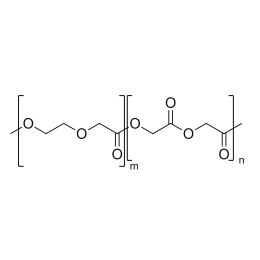 Poly(Dioxanone-co-glycolide), 90:10, IV 1.9 dL/gCatalog Number 50073Inquire for availability.Phone: +(49) 6201-845200Email: [email protected]Poly(Dioxanone-co-glycolide) (PDOGA) is a biodegradable copolymer tuned for quick absorption and has applications with biomedical devices including surgical sutures, staples, meshes, and controlled drug delivery.
Poly(Dioxanone-co-glycolide), 90:10, IV 1.9 dL/gCatalog Number 50073Inquire for availability.Phone: +(49) 6201-845200Email: [email protected]Poly(Dioxanone-co-glycolide) (PDOGA) is a biodegradable copolymer tuned for quick absorption and has applications with biomedical devices including surgical sutures, staples, meshes, and controlled drug delivery. -
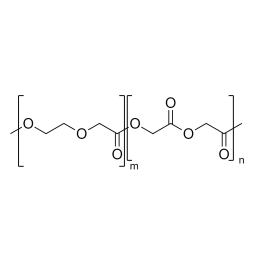 Poly(Dioxanone-co-glycolide), 90:10, IV 2.1 dL/gCatalog Number 50074Inquire for availability.Phone: +(49) 6201-845200Email: [email protected]Poly(Dioxanone-co-glycolide) (PDOGA) is a biodegradable copolymer tuned for quick absorption and has applications with biomedical devices including surgical sutures, staples, meshes, and controlled drug delivery.
Poly(Dioxanone-co-glycolide), 90:10, IV 2.1 dL/gCatalog Number 50074Inquire for availability.Phone: +(49) 6201-845200Email: [email protected]Poly(Dioxanone-co-glycolide) (PDOGA) is a biodegradable copolymer tuned for quick absorption and has applications with biomedical devices including surgical sutures, staples, meshes, and controlled drug delivery. -
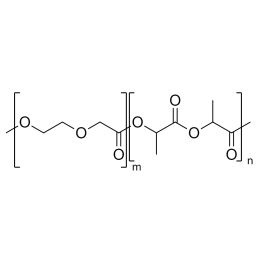 Poly(Dioxanone-co-lactide), 95:5, IV 1.9 dL/gCatalog Number 50075Inquire for availability.Phone: +(49) 6201-845200Email: [email protected]Poly(dioxanone-co-L-lactide) (PDO-PLA) is a biodegradable and biocompatible copolymer used in biomedical devices including staples, sutures, meshes, coatings, and controlled drug delivery.
Poly(Dioxanone-co-lactide), 95:5, IV 1.9 dL/gCatalog Number 50075Inquire for availability.Phone: +(49) 6201-845200Email: [email protected]Poly(dioxanone-co-L-lactide) (PDO-PLA) is a biodegradable and biocompatible copolymer used in biomedical devices including staples, sutures, meshes, coatings, and controlled drug delivery. -
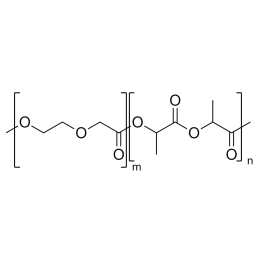 Poly(Dioxanone-co-lactide), 92:8, IV 1.3 dL/gCatalog Number 50076Inquire for availability.Phone: +(49) 6201-845200Email: [email protected]Poly(dioxanone-co-L-lactide) (PDO-PLA) is a biodegradable and biocompatible copolymer used in biomedical devices including staples, sutures, meshes, coatings, and controlled drug delivery.
Poly(Dioxanone-co-lactide), 92:8, IV 1.3 dL/gCatalog Number 50076Inquire for availability.Phone: +(49) 6201-845200Email: [email protected]Poly(dioxanone-co-L-lactide) (PDO-PLA) is a biodegradable and biocompatible copolymer used in biomedical devices including staples, sutures, meshes, coatings, and controlled drug delivery. -
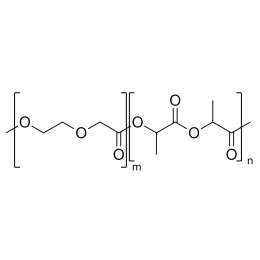 Poly(Dioxanone-co-lactide), 90:10, IV 2.0 dL/gCatalog Number 50077Inquire for availability.Phone: +(49) 6201-845200Email: [email protected]Poly(dioxanone-co-L-lactide) (PDO-PLA) is a biodegradable and biocompatible copolymer used in biomedical devices including staples, sutures, meshes, coatings, and controlled drug delivery.
Poly(Dioxanone-co-lactide), 90:10, IV 2.0 dL/gCatalog Number 50077Inquire for availability.Phone: +(49) 6201-845200Email: [email protected]Poly(dioxanone-co-L-lactide) (PDO-PLA) is a biodegradable and biocompatible copolymer used in biomedical devices including staples, sutures, meshes, coatings, and controlled drug delivery. -
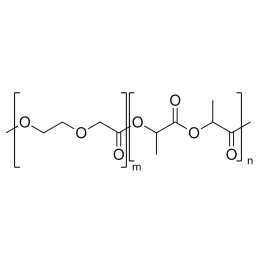 Poly(Dioxanone-co-lactide), 85:15, IV 2.1 dL/gCatalog Number 50078Inquire for availability.Phone: +(49) 6201-845200Email: [email protected]Poly(dioxanone-co-L-lactide) (PDO-PLA) is a biodegradable and biocompatible copolymer used in biomedical devices including staples, sutures, meshes, coatings, and controlled drug delivery.
Poly(Dioxanone-co-lactide), 85:15, IV 2.1 dL/gCatalog Number 50078Inquire for availability.Phone: +(49) 6201-845200Email: [email protected]Poly(dioxanone-co-L-lactide) (PDO-PLA) is a biodegradable and biocompatible copolymer used in biomedical devices including staples, sutures, meshes, coatings, and controlled drug delivery. -
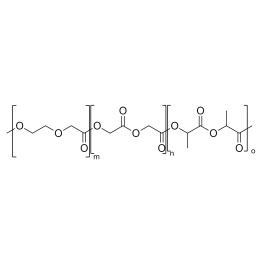 Poly(Dioxanone-co-lactide-co-glycolide), 90:5:5, IV 2.2 dL/gCatalog Number 50079Inquire for availability.Phone: +(49) 6201-845200Email: [email protected]Poly(Dioxanone-co-lactide-co-glycolide) (PDO-PLGA) is a biodegradable and biocompatible copolymer used in biomedical devices including staples, sutures, meshes, coatings, and controlled drug delivery.
Poly(Dioxanone-co-lactide-co-glycolide), 90:5:5, IV 2.2 dL/gCatalog Number 50079Inquire for availability.Phone: +(49) 6201-845200Email: [email protected]Poly(Dioxanone-co-lactide-co-glycolide) (PDO-PLGA) is a biodegradable and biocompatible copolymer used in biomedical devices including staples, sutures, meshes, coatings, and controlled drug delivery. -
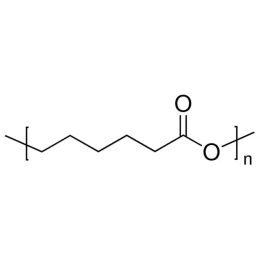 Polycaprolactone, IV 0.2 dL/g, PowderCatalog Number 50310Suitable for biomedical research. Supplied as a powder.
Polycaprolactone, IV 0.2 dL/g, PowderCatalog Number 50310Suitable for biomedical research. Supplied as a powder. -
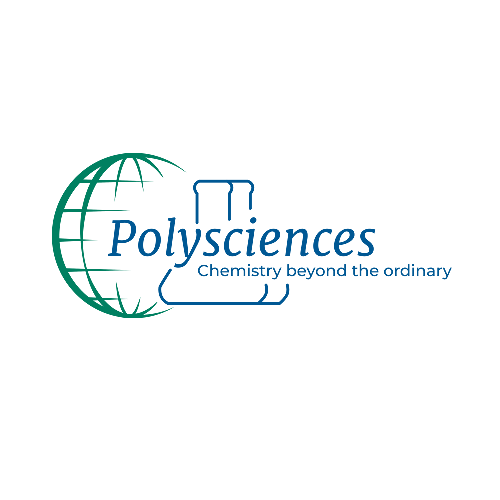 Polycaprolactone, IV 0.6 dL/g, PowderCatalog Number 50311Suitable for biomedical research. Supplied as a powder.
Polycaprolactone, IV 0.6 dL/g, PowderCatalog Number 50311Suitable for biomedical research. Supplied as a powder. -
 Polycaprolactone, IV 1.0 dL/g, PowderCatalog Number 50312Suitable for biomedical research. Supplied as a powder.
Polycaprolactone, IV 1.0 dL/g, PowderCatalog Number 50312Suitable for biomedical research. Supplied as a powder. -
 Polycaprolactone, IV 1.5 dL/g, PowderCatalog Number 50313Suitable for biomedical research. Supplied as a powder.
Polycaprolactone, IV 1.5 dL/g, PowderCatalog Number 50313Suitable for biomedical research. Supplied as a powder. -
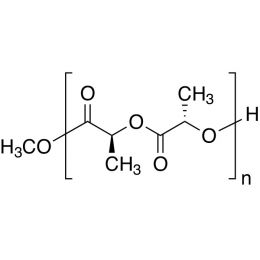 Poly(L-lactic acid), IV 0.15 dl/gCatalog Number 18580
Poly(L-lactic acid), IV 0.15 dl/gCatalog Number 18580Biodegradable polymer. Degradation rate is inversely related to polymer molecular weight.
Crystalline polymer with higher molecular weight polymers having a crystallinity of about 70%.
-
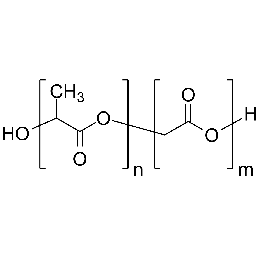 Poly(D,L-lactide-co-glycolide), 50:50, IV 0.4 dl/g, acid-terminatedCatalog Number 26270
Poly(D,L-lactide-co-glycolide), 50:50, IV 0.4 dl/g, acid-terminatedCatalog Number 26270 -
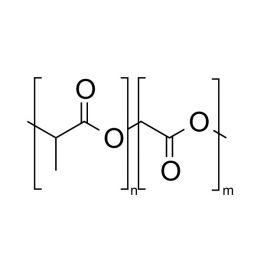 Poly(D,L-lactide-co-glycolide), 50:50, IV 0.6 dl/gCatalog Number 23986
Poly(D,L-lactide-co-glycolide), 50:50, IV 0.6 dl/gCatalog Number 23986Biodegradable polymers. Copolymers are easier to fabricate than homopolymers.
Soluble in: MDC, THF, ethyl acetate, acetone
50/50 i.v. 0.50-0.65
-
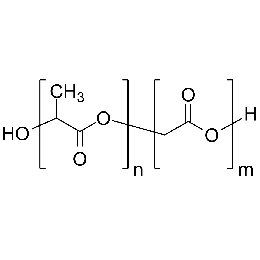 Poly(D,L-lactide-co-glycolide), 75:25, IV 0.2 dl/g, acid-terminatedCatalog Number 26268
Poly(D,L-lactide-co-glycolide), 75:25, IV 0.2 dl/g, acid-terminatedCatalog Number 26268 -
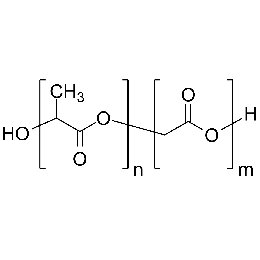 Poly(D,L-lactide-co-glycolide), 50:50, IV 0.2 dl/g, acid-terminatedCatalog Number 26269
Poly(D,L-lactide-co-glycolide), 50:50, IV 0.2 dl/g, acid-terminatedCatalog Number 26269 -
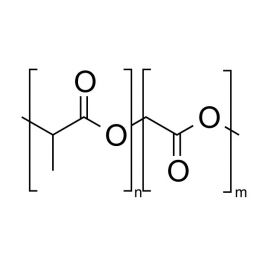 Poly(D,L-lactide-co-glycolide), 70:30, IV 0.2 dl/gCatalog Number 19247
Poly(D,L-lactide-co-glycolide), 70:30, IV 0.2 dl/gCatalog Number 19247Biodegradable polymers. Copolymers are easier to fabricate than homopolymers.
Soluble in: MDC, THF, ethyl acetate, acetone
70:30 i.v. 0.12-0.30 dl/g
-
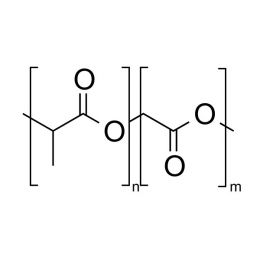 Poly(D,L-lactide-co-glycolide), 80:20, IV 0.2 dl/gCatalog Number 19077
Poly(D,L-lactide-co-glycolide), 80:20, IV 0.2 dl/gCatalog Number 19077Biodegradable polymers. Copolymers are easier to fabricate than homopolymers.
Soluble in: MDC, THF, ethyl acetate, acetone
80:20 i.v. 0.15-0.30
-
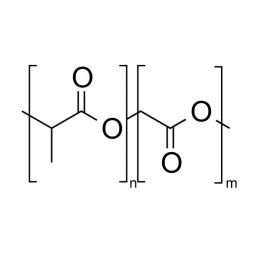 Poly(D,L-lactide-co-glycolide), 75:25, IV 0.65 dl/gCatalog Number 25107
Poly(D,L-lactide-co-glycolide), 75:25, IV 0.65 dl/gCatalog Number 25107Biodegradable polymers. Copolymers are easier to fabricate than homopolymers.
75:25
-
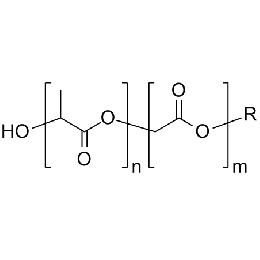 Poly(D,L-lactide-co-glycolide), 50:50, IV 1.0 dl/gCatalog Number 23987
Poly(D,L-lactide-co-glycolide), 50:50, IV 1.0 dl/gCatalog Number 23987Biodegradable polymer. Copolymers are easier to fabricate than homopolymers.
[50:50] i.v. 0.8-1.2
Soluble in: MDC, THF, ethyl acetate, acetone
-
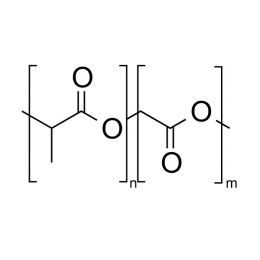 Poly(D,L-lactide-co-glycolide), 50:50, IV 0.40 dl/gCatalog Number 26297
Poly(D,L-lactide-co-glycolide), 50:50, IV 0.40 dl/gCatalog Number 26297
Biodegradable Polymers
